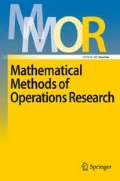Abstract
Fluid models are used to study functionals of the underlying random processes. Instead of analysing the trajectories, we investigate algebraic equations of the dynamic programming type which turn out to be discrete analogs of the corresponding differential equations. This analysis makes it possible to estimate the accuracy of approximation. Since the algebraic equations are the same for random walks and continuous time birth-and-death processes, we study the two cases in parallel. Several illustrative examples are also presented.
Similar content being viewed by others
References
Altman E (1999) Constrained Markov decision processes. Chapman and Hall/CRC, Boca Raton
Altman E, Jimenez T, Koole G (2001) On the comparison of queueing systems with their fluid limits. Prob Eng Inform Sci 15: 165–178
Avrachenkov K, Ayesta U, Piunovskiy A (2005) Optimal choice of the buffer size in the Internet routers. In: Proc. of CDC’05, 44-th IEEE conf. on Decision and Control, Spain
Bäuerle N (2002) Optimal control of queueing networks: an approach via fluid models. Adv Appl Prob 34: 313–328
Bremaud P (1999) Markov chains: Gibbs fields, Monte Carlo simulation, and Queues. Springer, New York
Clancy D, Piunovskiy A (2005) An explicit optimal isolation policy for a deterministic epidemic model. Appl Math Comput 163: 1109–1121
Dai JG (1995) On positive Harris recurrence of multiclass queueing networks: a unified approach via fluid limit models. Ann Appl Prob 5: 49–77
Dai JG, Meyn SP (1995) Stability and convergence of moments for multiclass queueing networks via fluid limit models. IEEE Trans Autom Control 40: 1889–1904
Ethier SN, Kurtz TG (1986) Markov processes: characterization and convergence. Wiley, New York
Foss S, Kovalevskii A (1999) A stability criterion via fluid limits and its application to a Polling system. Queueing Syst 32: 131–168
Gajrat AS, Hordijk A, Malyshev VA, Spieksma FM (1997) Fluid approximations of Markov decision chains. Markov Process Related Fields 3: 129–150
Gajrat AS, Hordijk A (2005) On the structure of the optimal server control for fluid networks. Math Meth Oper Res 62: 55–75
Hespanha JP, Bohacek S, Obraczka K, Lee J (2001) Hybrid modeling of TCP congestion control. In: Di Benedetto MD, Sangiovanni-Vincentelli A (eds) In hybrid systems: computation and control. Springer, Berlin, pp 291–304
Hordijk A, Spieksma F (1992) On ergodicity and recurrence properties of a Markov chain with an application to an open Jackson network. Adv Appl Prob 24: 343–376
Kemeny JG, Snell JL, Knapp AW (1976) Denumerable Markov chains. Springer, New York
Knessl Ch, Tier Ch (2001) A simple fluid model for servicing priority traffic. IEEE Trans Autom Control 46: 909–914
Korobeinikov A (2007) Global properties of infectious disease models with nonlinear incidence. Bull Math Biol 69: 1871–1886
Li QL, Zhao YQ (2005) Block-structured fluid queues driven by QBD processes. Stoch Anal Appl 23: 1087–1112
Maglaras C (2006) Revenue management for a multiclass single-server queue via a fluid model analysis. Oper Res 54: 914–932
Mandelbaum A, Pats G (1994) State-dependent queues: approximations and applications. In: Kelly F, Williams R (eds) Stochastic Networks, Proc. of the IMA, vol 71. Springer, New York, pp 239–282
Mandelbaum A, Massey WA, Reiman MI (1998) Strong approximations for Markovian service networks. Queueing Syst 30: 149–201
Meyn SP, Tweedie RL (1993) Stability of Markovian processes III: Foster-Lyapunov criteria for continuous-time processes. Adv Appl Prob 25: 518–548
Mitra D (1988) Stochastic theory of a fluid model of producers and consumers coupled by a buffer. Adv Appl Prob 20: 646–676
Piunovskiy A (2004) Multicriteria impulsive control of jump Markov processes. Math Meth Oper Res 60: 125–144
Puterman M (1994) Markov decision processes. Wiley, New York
Trenoguine V (1985) Analyse Fonctionnelle. Mir, Moscow (French)
Warburton RDH (2004) An exact analytical solution to the production inventory control problem. Int J Prod Econ 92: 81–96
Author information
Authors and Affiliations
Corresponding author
Rights and permissions
About this article
Cite this article
Piunovskiy, A.B. Random walk, birth-and-death process and their fluid approximations: absorbing case. Math Meth Oper Res 70, 285–312 (2009). https://doi.org/10.1007/s00186-008-0269-y
Received:
Revised:
Published:
Issue Date:
DOI: https://doi.org/10.1007/s00186-008-0269-y



